Quince Japanese, or Henomelles - a long-term decorative shrub. In addition to decorative properties, it is also a fruit culture, but because for the season the fruits do not always have time to grow in the middle strip of Russia, first of all, the shrub is used as a decorative decoration of urban flower beds and summer cottages.
Quince Japanese description
Henomelles is a thermo-loving plant, frost resistance of shrub up to -30 ° C, but unpleasant annual branches in a walking winter frozen, frozen and wrapped on perennial branches, and then blooms and fruits shrubs only at the bottom of the branches.
In the spring Quince brightly blooms with aluminum flowers, similar to the apple bodies, moreover, bloom begins when the leaves are still practically no. There are also varieties with pink and white flowers. Duration of flowering - about 3 weeks. The branches and shoots of the plant arcuate, densely covered with dark green, shiny leaves. Most of the types of Henomelles have breakdowns with a barrels of 1-2 cm long. Fruits of a small size are tightly attached to the branches. Despite the small size of the Kusta, the adult plant to transplant is almost unrealistic, since Quince has a long, thick rod root.
Fruption begins with the 3-4th year of the life of the plant. The fruits of quince of Japanese round or pear-shaped shape with yellow dense skin, are valued for the high content of vitamin C, they are also called "Northern Lemon". If the fruits have not caused over the season, they are removed to the first cold, and they are waiting for ripening at home. In the fresh form, quince apple is unsuitable for use, since they are very solid and sour. From quince prepare jams, compotes, add to jam to impart fragrance. Store as a whole, or cut into slices and are richly breathed with sugar like lemons.
Quince Japanese landing
For landings, two-year plants are chosen and plant early spring to the dissolution of the kidneys. Japanese quince seedlings can be purchased in nurseries both with an open root system, and immediately in pots, with a closed root system, then they can be planted at any time, without damaging the roots of the plant.
IIVA Japanese is a long-lived plant, and in one place there are 50 years old and more, so it is advised to choose a place for the choice. Henomelaes plant on a sunny, windless plot. On the sun, the shoots are matured faster and better winter, and the fruits have time to mature before the onset of frosts. It is desirable that in the winter time in this place remains as much snow.
Light, loose sandy soils are suitable for quince. There are no special requirements for the composition of the soil, but if you put a fertilizer in the soil, the plant will quickly and actively develop.
Adult Kush Henomelhes in height reaches one and a half meters, and the same in diameter, therefore, when landing, the distance between the plants is maintained with 1.5-2 m. The exception is landing as a living hedge, in this case, bushes are sitting at a distance of 0.5 m. Friend, when expanding the plant, the plants are closed and form a spiny green fence.
For landing Quince Japanese, the landing pit is preparing, in which a large number of organic fertilizers are made, such as overwhelmed null and compost, and complex mineral fertilizers. The neck of the plant does not plunge, leaving it at the level of the soil, in the case of the autumn landing of the Japanese quince. After landing, the plant is abundantly watered.
Quince Japanese care
The cultivation of quince Japanese is an easy to perform the task, as it is an extremely unpretentious plant. If you don't care for quince at all, it will still survive, and for a long time will delight you with beautiful bloom.
Winter care
Because the frost resistance of the japanese japanese bushes, for more abundant flowering on the winter branch of the plant bend to the ground, so that they remain under the snow in the frost. Additionally, the shrubs of the fallen foliage of fruit trees are covered, young plants in the cold regions are hiding under the underfloor material.
Watering
In summer, watering moderate, just once every month. If the summer arid, watered more often, but even if not to water the plant at all, it will not die. The root of the shrub is a long rod, and goes far deep down, so Quince tolerates drought perfectly.
Podchar
Starting from the second year of life, Henomeles fertility:
- The first feeding is carried out in early spring, nitrogen fertilizers are entered into the ground.
- The second feeding is the introduction of nitrogen fertilizers during flowering.
- The third feeding is carried out in the fall, as for many other plants, phosphorus-potash fertilizers are made under the quince.
Trimming
Once in 3-4 years, the prophylactic trimming of the shrub is carried out. In the fall, after the dejunction of foliage, the old brutal branches are elderly 5 years, leave no more than 15 shoots. The first such trimming of the plant is necessary at the age of 8-10 years. When trimming, first of all, the branches are closest to the ground, and shoots growing vertically. Plants used as a living hedge, halted every year, giving them a decorative appearance. In the spring, henomelaes shoots franmble for winter. For haircuts use garden scissors and a secateur, the procedure is carried out in gloves so as not to be hurt.
IIVA Japanese in large quantities gives the roasting pig. Leave 3-4 tanks that will be used to reproduce the plant, the rest are digging, bringing the roots of the tank shovels. If you do not delete the drains, then at the age of 20, the bush will take an area of \u200b\u200bup to 2 m 2.
Diseases
Japanese quince practically does not hurt, the pests bypass. If nevertheless pests are seen on the iphiv, the shrub of insecticides is performed.
In case of appearance on the leaves of traces of damage to fungal diseases, the plant is treated with fungicides.
Quince Japanese reproduction
The most common and most effective way of reproduction of Quince Japanese - cultivation of seeds. Consider all possible ways of breeding shrubs.
Reproduction of seeds
Japanese quince fruits have many seeds that resemble apple seeds. Seeds are harvested with mature fruits and sowed in the soil in the fall. The germination of seeds is very high, and already in the spring they give violent shoots. At a biennium, seedlings are transferred to a permanent habitat, since even at that age the plant develops a rather long root that is easy to damage during transplantation.
Reproduction of roasting chains
To obtain a new plant, they choose strong grooves from the roasting piglets with a thickness of up to 0.5 cm. They prefer such that the root system is better developed. It is embarrassed in the prepared place vertically, it is abundantly watered and mulched by humus, sawdust or bark of trees. The root system of such seedlings is formed long, and they slowly develop. Without regular irrigation at the plant rooting stage dying.
Vegetative breeding methods
The reproduction of cuttings and the vaccination of the Japanese quince allows you to get all the maternal properties of a varietal shrub in a young sapling. The branches for the drawing are cut in June, while the cuttings must contain 2 interstices on the stem of last year, and at the base have a fragment of 1 cm long by last year's branch. The prepared material is withstanding a day in solution to improve the root formation, then planted at an angle of 45 ° in peat ground and pour out. The rooting lasts 1-1.5 months, as a rule, no more than 50% of the cuttings are rooted.
The vaccination is made by a sprig of a varietal plant on the Henomelase seedman to improve the quality of the seedling, transfer the properties of a varietal plant. The vaccination make not only the seedlings of Henomelles, but also to other related plants, such as a pear, rowan, hawthorn, Irga. You can instill several types of varietal quilts and get a unique plant. The vaccination is done in May, the varietal branch of the platter is being taken at the dating of one of the standard vaccination methods, the best results are obtained from the vaccination "in the split". The vaccination location is processed by a garden boiler and grinds tightly.
We instill varietal kidneys and the method of eyepiece, the procedure is carried out in July-August. During the vaccination, in no case cannot touch the location of the cut off with your fingers, it should be made a sharp knife into one move. The place of the eyelid is carefully lit up with the kidney. After a month, the skills of the kidneys check, remove the bandage. Spring Escape above the kidney is removed to send juices to send to the kidney we need. The location of the escape is treated with garden harr.
Quince Japanese variety
There are about 500 varieties of quince Japanese, but the climatic conditions of Russia allow you to grow only some of them. Most often in Russia there are American and Dutch grades of Henomelles. Consider some of them:
- Pink Lady (Pink Lady) - shrub height up to one and a half meters, rounded shape. Pink flowers from light to dark shades. Quite quickly develops.
- Hollandia (Holland) is a height of 1.5 m, the crown is rounded, branched, grows slowly. Colors a lot, the color of salmon pink.
- Vesuvius (Vesuvius) is a low slow-growing bush to the 1st meter of height, the crown is stretched, up to 1.5 m. Flowers are numerous, red.
- Nivalis (Niviss) is a rather large shrub, the diameter of the crown to 2 meters, the shape of the bush is rounded. It grows rapidly, a distinctive feature is bloom twice a year, the first time - in May, and re-in August. White flowers.
- CRIMSON AND GOLD (CRIMSON END GOLD) is a slow-growing bush up to 1.2 m, crown stretched, dark red flowers, yellow stamens. Fruits with a reddish blush.
Iiva Japanese: photo
As you can see, IIVA Japanese is a high-temperature shrub, widely used for various purposes. Choosing a seedlove, you can choose a variety of plants with the desired color and form of colors, the size of fruits, shape of the shrub. Unusual flowerbed or a live fence will be from plants with different colors of flowers.

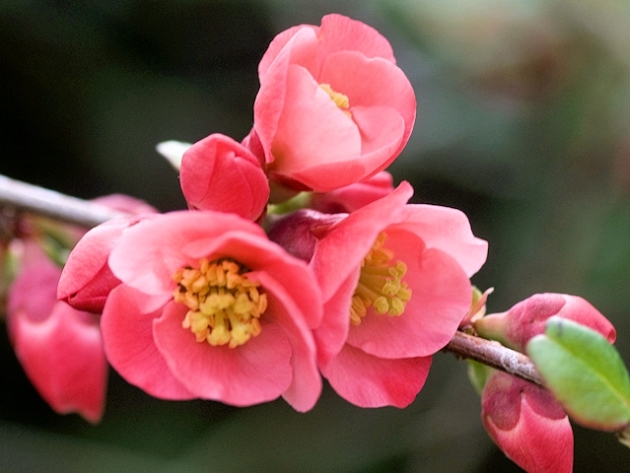

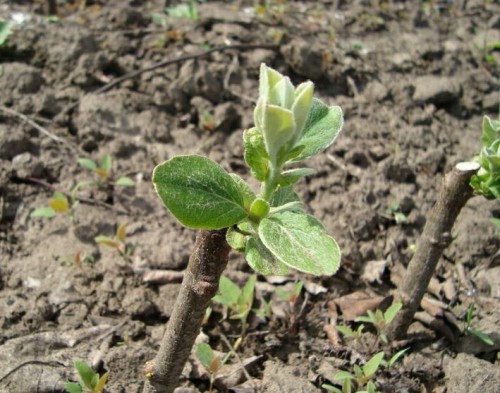
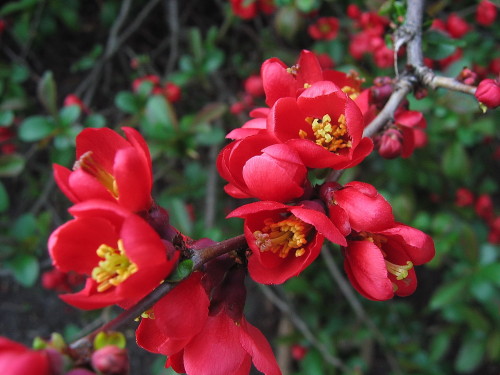
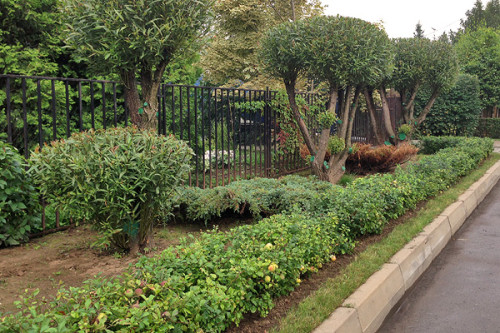
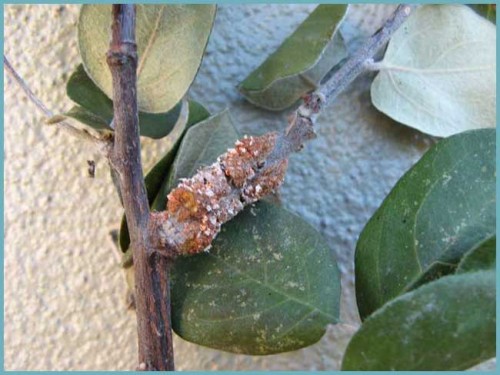
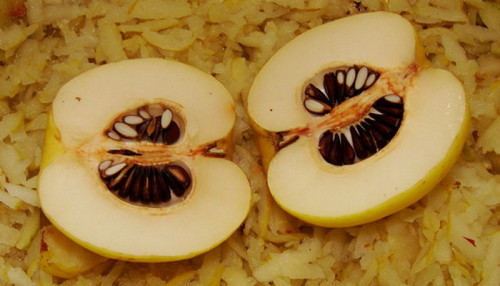
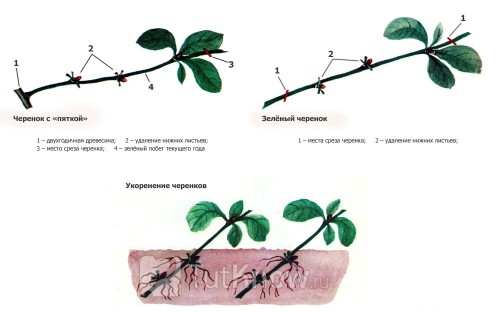
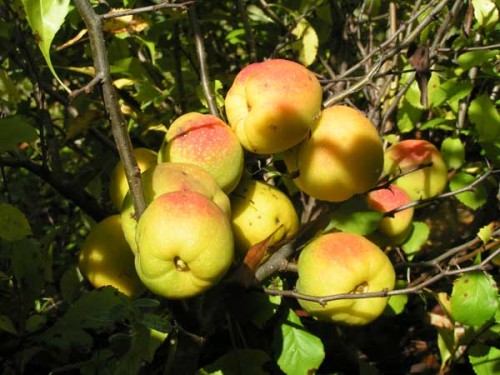
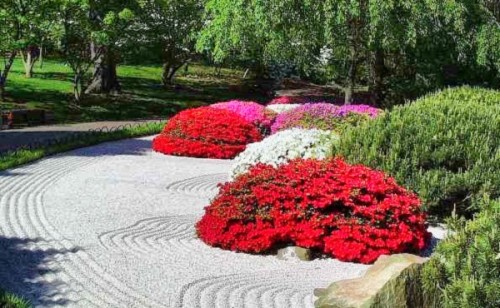
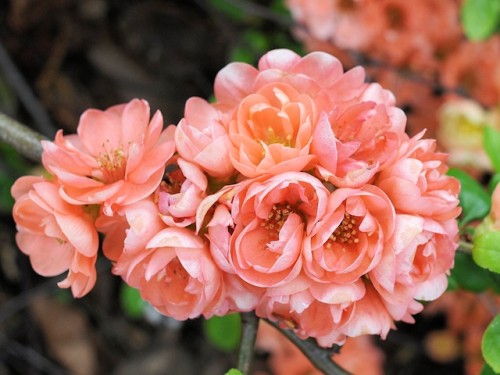
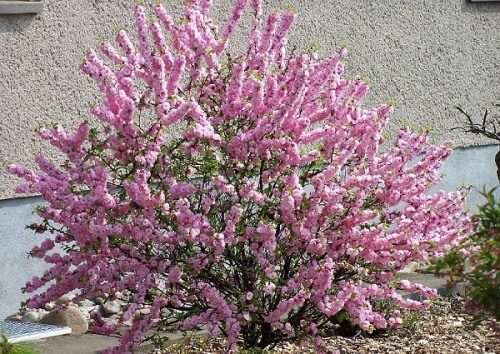
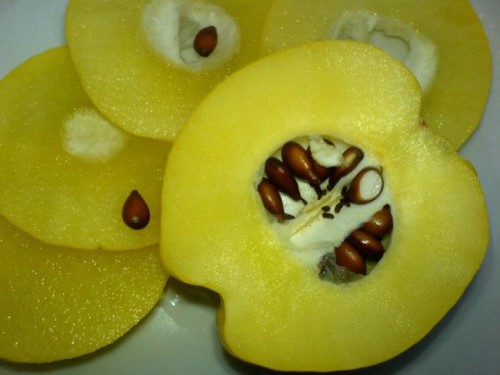












 Start a discussion ...
Start a discussion ...